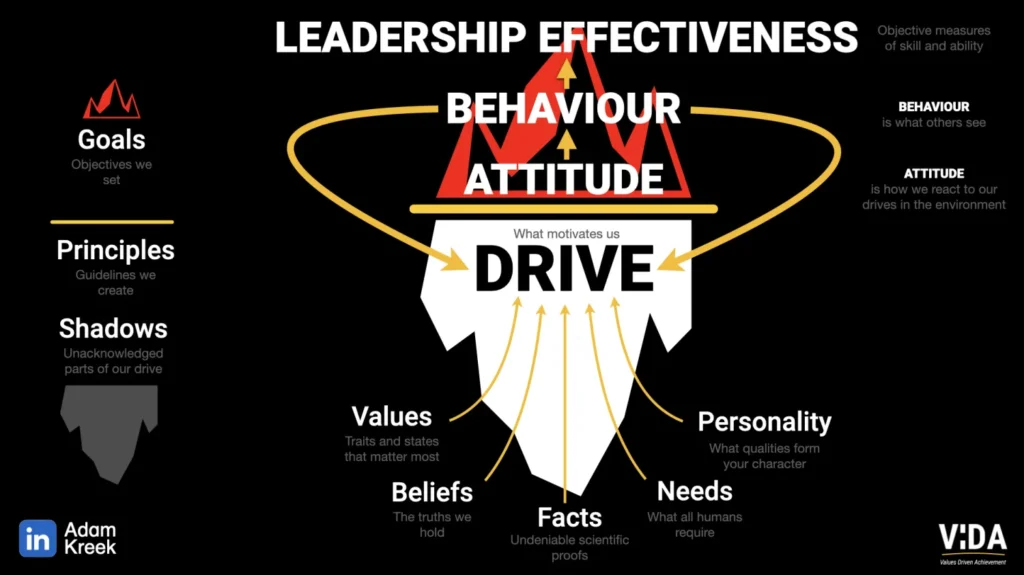
"Leadership is about empathy. It is about having the ability to relate and to connect with people for the purpose of inspiring and empowering their lives."
Oprah Winfrey
Media Tycoon
- Date
Leadership Drives: Why What You Don’t See Is Driving the Show
posted in Leadership

Adam Kreek
When we talk about leadership effectiveness, most people jump straight to behaviour.
And fair enough. Behaviour is what we see. It’s the meeting tone, the strategic choice, the offhand comment in a hallway, the hiring decision. It’s what gets measured in 360 reviews and judged in the boardroom.
But behaviour is just the tip of the iceberg.
If you want to improve your leadership effectiveness—for real—you have to look below the surface. That’s where the drives live. And that’s what this model is about.
Behaviour is What Others See
But it’s not where leadership begins.
We usually judge leaders by what they do. But if you stop there, you’re just doing surface diagnostics. You’re trying to fix the trajectory of a rocket without examining the fuel. If you want to shift performance, team cohesion, decision-making, or even your own energy levels, you’ve got to start with what’s driving it all.

The Anatomy of a Leadership Iceberg
Here’s how it breaks down:
1. DRIVE
This is your propulsion system. It’s invisible to others, but you feel it deeply. Drives come from multiple sources, and they power everything above the waterline.
There are six key inputs into your drive system:
- Values – Traits and states that matter most to you.
- Beliefs – The truths you hold, consciously or not.
- Facts – The reality of your context (family, culture, race, politics, environment).
- Needs – From survival to self-actualization. Think Maslow.
- Personality – Your pattern of traits. I’m a fan of Predictive Index for this.
- Shadow – The parts of your drive you haven’t acknowledged or accepted yet.
You can’t always control your drives. But you can learn to recognize them, understand them, and make decisions that bring them into alignment.
2. ATTITUDE
This is how you interpret your drives in real time.
Attitude is the lens you use to decide how to react to your current context. It filters your drive and determines how you show up. This is the fulcrum point of leadership work. Because even if you’ve done all the drive discovery work, if your attitude filters are off, your behaviours will be too.
Attitude changes with awareness. It improves with coaching, with values clarification, and with goal-setting. And it’s massively impacted by stress, context, and fatigue.
3. BEHAVIOUR
Now we’re above the waterline.
Behaviour is what people can see and measure. It’s your tone of voice, your reaction to pressure, your listening skills, your ability to hold boundaries, your follow-through.
The key idea: Better behaviour starts with better awareness of the layers below it.
How to Lead With More Awareness (and Less Guesswork)
If you want to become a more effective leader—under pressure, in public, or in private—you need to activate a few tools to influence the layers under your behaviour:
🔴 Goals
What you aim at determines how you move.
Your goals act as magnets, pulling your behaviour and decisions in a particular direction. When goals are misaligned with values, you feel internal resistance. When they’re in sync? Flow.
Ask: Are my goals amplifying the best parts of my drive? Or are they feeding a shadow?
🟡 Principles
Simple rules that shape complex behaviour.
Principles are like coding functions for your leadership system. They help you automate ethical, aligned, high-integrity decisions—especially under stress.
Examples:
- “Say the hard thing first.”
- “Always honour the team over the timeline.”
- “Don’t mistake urgency for importance.”
Your principles should come directly from your values—not from inherited corporate dogma.
⚫ Shadows
Unacknowledged parts of your drive.
You can’t lead from your values if you’re being driven by your fears. Shadow values (like status, control, revenge, perfectionism) often masquerade as good leadership—until they don’t.
Shadow drives are often rewarded early in your career and become hardwired into your success system. The only way to change them is to name them. This is where the real work begins.
Final Thought:
Effective leadership starts below the waterline.
You can’t whiteboard your way to better behaviour. You have to do the deeper work.
Get clear on what drives you.
Set goals that serve your values.
Build principles that regulate your instincts.
Do the shadow work that makes space for wholeness.
Then you’ll show up with behaviour that’s not just effective—but consistent, values-aligned, and resilient under pressure.
Want to go deeper?
Take the ViDA course on values and drive-based leadership. Or check out the companion blog: Shadow Values and the Iceberg Under the Brand
–––––
Adam Kreek and his team are on a mission to positively impact organizational cultures and leaders who make things happen.
He authored the bestselling business book, The Responsibility Ethic: 12 Strategies Exceptional People Use to Do the Work and Make Success Happen.
Want to increase your leadership achievement? Learn more about Kreek’s coaching here.
Want to book a keynote that leaves a lasting impact? Learn more about Kreek’s live event service here.